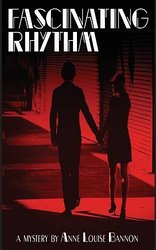 Relevant History welcomes Anne Louise Bannon, an author and journalist who wrote her first novel at age fifteen. Her journalistic work has appeared in magazines and newspapers across the country. She was a TV critic for over ten years, and created the Odd Ball Grape wine education blog with her husband, Michael Holland. She also writes the romantic fiction serial White House Rhapsody. She is the co-author of Howdunit: Book of Poisons with Serita Stevens, as well as mysteries Fascinating Rhythm, Bring Into Bondage, and Tyger, Tyger. She and her husband live in Southern California with an assortment of critters. To learn more about her and her books, visit her web site, and follow her on Facebook, Twitter, Google+, and Pinterest.
Relevant History welcomes Anne Louise Bannon, an author and journalist who wrote her first novel at age fifteen. Her journalistic work has appeared in magazines and newspapers across the country. She was a TV critic for over ten years, and created the Odd Ball Grape wine education blog with her husband, Michael Holland. She also writes the romantic fiction serial White House Rhapsody. She is the co-author of Howdunit: Book of Poisons with Serita Stevens, as well as mysteries Fascinating Rhythm, Bring Into Bondage, and Tyger, Tyger. She and her husband live in Southern California with an assortment of critters. To learn more about her and her books, visit her web site, and follow her on Facebook, Twitter, Google+, and Pinterest.
*****
It’s hard to tell the behind-the-scenes story of my latest novel Bring Into Bondage without mentioning the book that came before it, Fascinating Rhythm. The books are set in the 1920s and feature editor Kathy Briscow and her socialite author boyfriend Freddie Little. In Fascinating Rhythm, we find out that Kathy comes from Hays, Kansas, a small farming town pretty much dead center in the country, which in turn becomes the setting for Bring Into Bondage.
I purposely chose a rural town for Kathy’s original home. Right after World War I, the country started urbanizing, and as of the 1920 census, just over half the U.S. population lived in cities for the first time ever. Barely fifty years before, only five percent of the population had. One of the hot tunes from that post-Great War era was “How You Gonna Keep ‘Em Down on the Farm (After They’ve Seen Paree?)” It was not only happening, it was on people’s minds. So it made sense that my feisty office worker came from a rural background.
I didn’t realize it at the time, but it was a far richer background than I thought. Okay, I did know, in a vague, “they said so in history class” kind of way that what we know as The Great Depression actually started for American farmers shortly after the end of World War I. But what caused the farming depression, namely debt, became one of the underlying themes in Bring Into Bondage, which is set on the farm belonging to Kathy’s parents.
There were a lot of different causes, but basically, farmers were caught in a spiral of producing too much, which caused crop prices to fall, then having to produce more to make up for it, causing crop prices to fall still lower. Frederick Lewis Allen, in his short history of the decade, Only Yesterday, partially laid the blame on mechanization. But other sources have also pointed out that the farmers had seen a boom in crop prices during the Great War, when not only did they feed the U.S., they exported crops to war-torn Europe. Once the war was over, so was the need for imported food. Which meant an even larger supply in the U.S. In any case, what caused the larger part of farmers’ problems was that they took out mortgages to either buy more land or to buy the new mechanical equipment.
Farming has never been easy. But in the 1920s, there were no subsidies and no other social safety nets. You relied on your neighbors, as Kathy’s family does, even though the family farm is under attack by mysterious vandals. Freddie mentally refers to Kathy’s family as being dirt poor. There’s a sense of frugality in this family that we don’t recognize today in our abundant, throw-away culture. When Ma Briscow sends the five-word telegram to summon Kathy home, Kathy is upset because Ma uses two words she didn’t need. Telegrams cost five cents per word, and to carelessly spend ten cents when every penny counts means Ma is very upset indeed.
The title of the book comes from the biblical book Nehemiah (5:5), in which some of the Israelites are complaining that they can’t get justice for their children, who have been sold into bondage, because other men have their lands. In short, they have been mortgaged out to the hilt and are now in bondage, themselves. Kind of like farmers in Kansas were in the 1920s.
*****
 A big thanks to Anne Louise Bannon. She’ll give away a copy of Fascinating Rhythm to someone who contributes a comment on my blog this week. I’ll choose the winner from among those who comment by Friday at 6 p.m. ET. Delivery is available worldwide for an ebook and in the U.S. only for a trade paperback.
A big thanks to Anne Louise Bannon. She’ll give away a copy of Fascinating Rhythm to someone who contributes a comment on my blog this week. I’ll choose the winner from among those who comment by Friday at 6 p.m. ET. Delivery is available worldwide for an ebook and in the U.S. only for a trade paperback.
**********
Did you like what you read? Learn about downloads, discounts, and special offers from Relevant History authors and Suzanne Adair. Subscribe to Suzanne’s free newsletter.

Loved your blog. I, too, write books set in the 1920s, but my folks live in big cities (well, Pasadena, CA, and Los Angeles, CA). That’s because I’m a city kid, too, and know nothin’ about farming. The ‘twenties are fascinating years, aren’t they?
Absolutely one of my fave eras. Although most of the series does take place in cities – mostly New York, although in the upcoming third book, Freddie and Kathy visit Los Angeles
Oh, and thanks so much for your comments. Your books are in my TBR pile, too. Really looking forward to the Pasadena setting, since I live near there.
The song Woody Guthrie wrote, Good By It’s Been Good to Know You during this time period was a reflection of people then believing the end of the world was at hand.
Sounds like it. Thanks for the thought.
Great post and your books are on my TBR pile now. Your blog reminded me of some of the stories my parents told about that era. My mother was a teenager and in school, and my father was barely out of his teens and working full time in NYC. Both had left farm regions in their earliest years and missed them–the open green land and sense of neighborhood. But they knew how hard that life was.
Wow, thanks for adding me to your pile. Would love to hear more about your folks’ experiences sometimes. Love oral history.
My father began farming in the 30s. I remember him saying once that if every farmer threw an egg against the wall every day, or poured out a quart of milk, prices would improve. (We had dairy and chickens.)
Yeah, I know. Cheap food is a problem. Those of us urbanites do forget that it costs money and labor to produce what we eat. (Was very tempted to get on that soapbox, but perhaps some other time). Thanks for sharing.
Sounds like a story I’ll love! In the late 20’s, my grandfather’s family lost their farm – it was the same story: the older brothers left Missouri (one having become a doctor, the other a lawyer). It was his responsibility to keep the farm going after they left and they couldn’t keep up. It changed the entire history of our family (he became a bootlegger, then a machinist when he fell in love and she insisted he straighten up – a story for another time). Can’t wait to look up both books!
Thank you so much for sharing. I love tales like this. As for the books, please be aware that the first book takes place in New York City. Kathy did leave the farm, after all. I hope you enjoy them.
I grew up in a small rural town in the Midwest. I remember my Grandmother telling of the Great Depression and of how little they had to eat. I think they survived by true grit.
A lot of folks did. Thanks for sharing, Joye.
Grew up on a tenant farm in Texas in the 40’s and 50’s – depression continued much later fro some farmers.
From what I’ve seen, farmers are still having a tough time.
Hi Anne,
Congrats on your stellar literary career! I would love to read ‘Bondage’ and its sequel. My grandmother lived in Hill City, KS– just north of Hays and so small it had only one traffic light, so I have some familiarity with the area.
Wow. That’s fascinating, Janice. And to think I had no clue. Thanks for the comment.